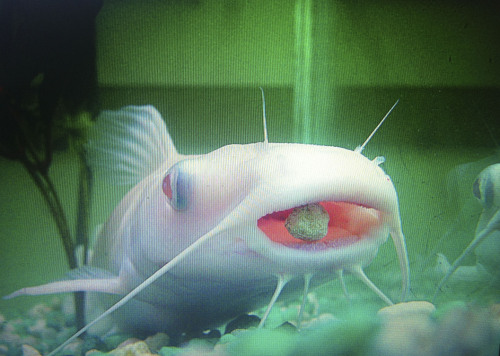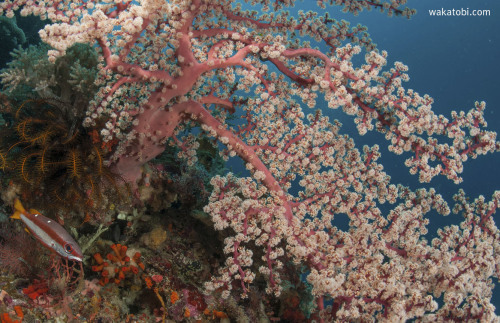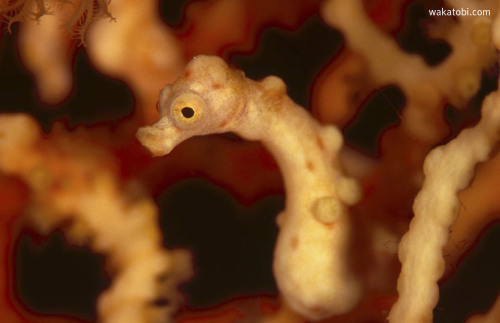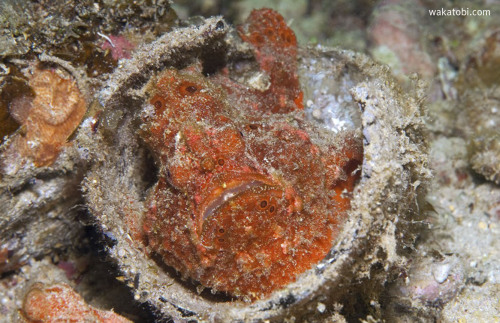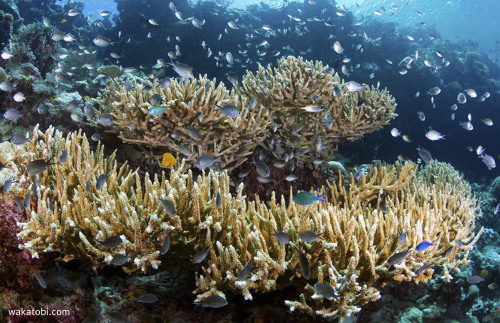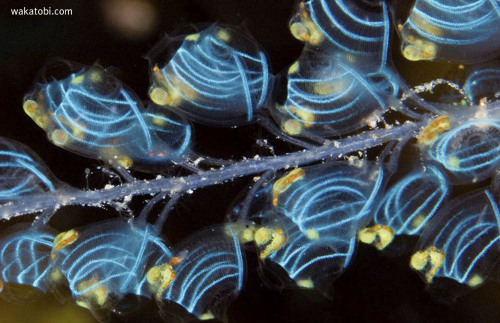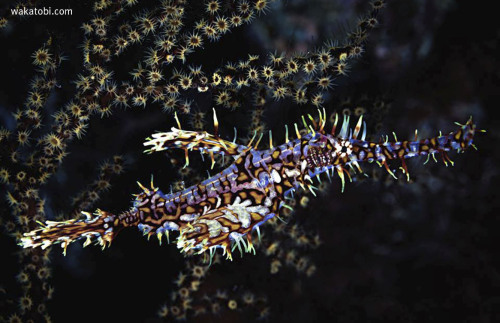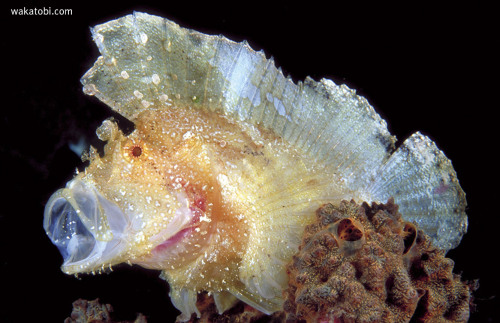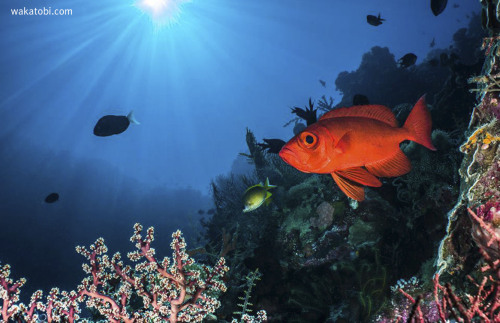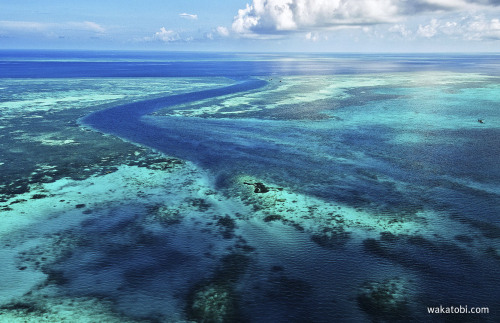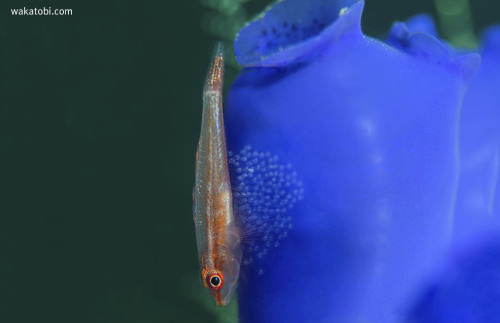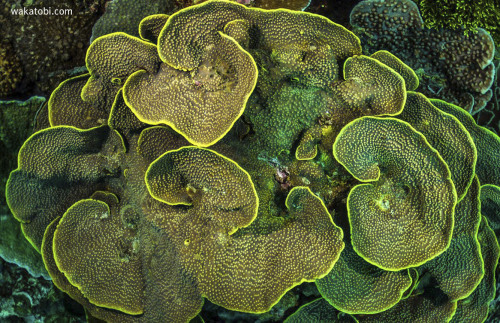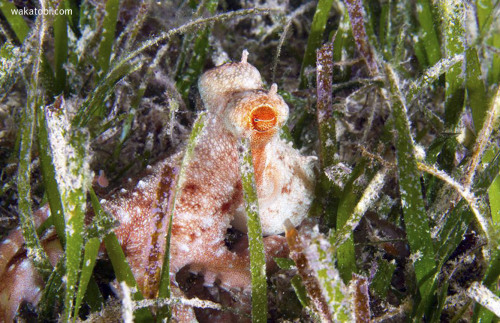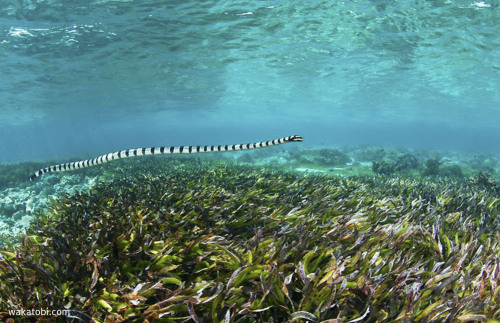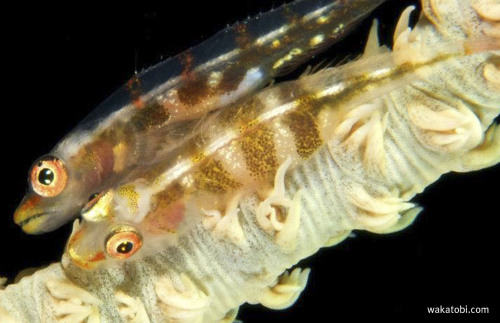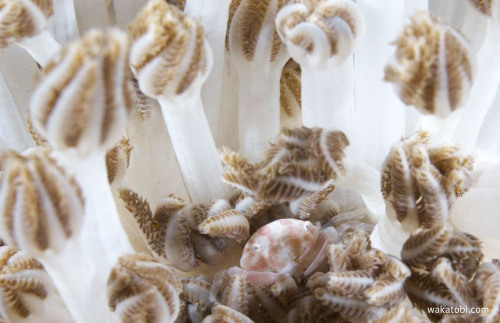#snorkeling
Coral polyps, stimulated by a near UV light. Initially believed to be a plant, coral is in fact an animal. While a coral head appears to be a single organism, it is actually a group of many individual, yet genetically identical, polyps. The polyps are multicellular organisms. Polyps are usually a few millimeters in diameter, and are formed by a layer of outer epithelium and inner jellylike tissue known as the mesoglea. They are radially symmetrical, with tentacles surrounding a central mouth, the only opening to the stomach or coelenteron, through which food is ingested and waste expelled. (Photograph: Mick Gulson)
Post link
During the day the Saron shrimp is brown with green spots and variable amounts of white speckling. The legs have darker brown bands on a brown background with alternating white speckled bands. Tufts of cirri (feathery appendages) are found decorating the back of the males, and their first pair of walking legs are elongated. The Saron Shrimp is nocturnal, and at night, the color of its body changes colour, turning primarily red, which helps it blend into the shadows of the twilight. It is found in the coral rubble at the base of the reef. (Photograph: Doug Richardson)
Post link
Also known as Godeffroy’s Soft Coral, this tree coral looks like the Japanese ‘sakura’ or cherry blossom tree. They feed on plankton and can grow to about 17cm in length. (Photograph: Eric Schlogl)
Post link
The Persian carpet flatworm has a very small geographic range mostly in the temperate shallow intertidal ocean waters of the Indo-West Pacific. Flatworms can move fast along the bottom by rapidly beating tiny hairs which act like millions of feet to propel them along in an undulating manner. They feed by placing themselves over their victims and sucking in their prey, a tube like extension in its mouth acts as a grinder. (Photograph: Anne Lecuire)
Post link
On the morning’s first dive, your guide leads you right to a pastel gorgonian that you would have otherwise swam right past. Following his gestures, you look close, then closer, and suddenly the timely and perfectly camouflaged profile of a Denise’s pygmy seahorse is revealed. Your guide places a steadying hand on your shoulder, allowing you to ease in for a close up without disturbing this tiny reef dweller or its surroundings. Your day is off to a pretty good start. (Photograph: Cor Bosman)
Post link
The colors and patterns of this fire urchin are as bright as a string of holiday lights, and seem to be lit from within. You’ll most likely encounter one of these colorful characters in the inshore areas of the House Reef and other sand-bottom dive sites. They are usually easy to spot, and they grow to diameters of eight inches. (Photograph by Erik Schlogl)
Post link
Into mucking around? If you are unfamiliar with the term muck diving, it is basically a treasure hunt for small and often highly cryptic critters hiding among the supporting columns of a pier or in debris - like this frogfish nestled, comfortably we assume, in the sandy bottom. (Photograph by Saskia van Wijk)
Post link
Wakatobi’s reefs are also rich in a rich variety of life. The region is known as the most bio-diverse coral ecosystem in the world, and with plenty of time to hover and watch, snorkelers can discover hundreds of fascinating species of fish and invertebrate life. Found just a few feet from the resort jetty, this orangutan crab took a stance as he shuffled within an anemone. (Photograph: Leon Joubert)
Post link
From this angle, it seems as if these red tube sponges are topped with seasonal greenery. Closer examination reveals it’s actually a black crinoid, growing from the reef just above, and silhouetted by morning light filtering down. (Photograph: Walt Stearns)
Post link
Some fish lay their eggs on convenient structures such as an extension of wire coral. (Photograph: Richard Smith)
Post link
Some of the garden eels live in big groups, but the spotted garden eel is more often found in smaller colonies or even singly. They rely on water motion to bring food to them, the garden eels typically live in current prone habitats. (Photograph: WDR)
Post link
Wakatobi delivers select luxury without sacrificing natural beauty. It is best known for its spectacular reefs, diverse marine life and world-class diving operations. But as thousands of our guests attest, it is not just the diving, but the entire resort experience that sets us apart. From the magnificent natural setting to the premier levels of personal service provided, we strive to make every element of a Wakatobi stay exceed expectations, and create memories of a lifetime. (Photograph: Didi Lotze)
Post link
Most cleaning stations can be found in the shallower areas of the reef, which allows divers to spend more time observing the activity. Finding one for the first time is not hard, but can require a watchful eye and little patience to see and recognize the activity. Wakatobi’s dive guides are experts at locating cleaning stations and will often help guests learn how to quickly spot the services being performed. (Photograph: Walt Stearns)
Post link
Spirals of electric blue pigment, created by granules suspended within the
translucent bodies of these colonial tunicates, create the underwater
equivalent of a sparkly light show, brightening up the reef on which
they live. (Photograph: Rob Darmanin)
Post link
Ornate Ghost Pipefish is probably the most well know species, which is also known as the Harlequin ghost pipefish. It is often found in pairs living along side crinoids (feather stars) and occurs in a startling rainbow of colour forms. Like the other species the ornate ghost pipefish is a predator of small mysid shrimp. Juveniles are almost transparent but are nearly adult length when they settle from their planktonic stage. (Photograph: Marco Fierli)
Post link
This well-camouflaged ambush predator spends most of its time resting motionless on the seafloor, looking more like part of the reef than a fish. When smaller fishes venture near, the scorpionfish makes a quick lunge and – opening its huge mouth in a fraction of a second – inhales the prey into its large mouth. Its excellent camouflage also helps it escape detection by predators. (Photograph: Rob Darmanin)
Post link
Mates for life, the Shrimp and the Goby have a mutually symbiotic relationship: They depend on each other to survive. The shrimp and goby are an amusing little couple, whose burrows are often found on coral overhangs or on a patch of sand or coral rubble. They have an interesting relationship and a very clear division of labor: The shrimp is virtually blind, but is an amazing burrower and a very hard worker. She works all day to maintain a tunnel that she will share with the goby, who needs a safe haven for protection. On the other hand, the goby acts as watchmen outside the tunnel, guarding the burrow, watching for prey or predator while the shrimp continues to ‘clean house’. (Photograph: Doug Richardson)
Post link
The barracuda is an opportunistic predator, feeding only on other animals in the surrounding water. The carnivorous barracuda primarily
feeds on smaller species of fish, marine invertebrates, crustaceans and
squid, which the barracuda usually ambushes with tremendous power.
(Photograph: Deborah Leenutaphong)
Post link
Seemingly wide-eyed in wonder, an aptly-named Big Eye hovers over a cluster of soft coral. The delicate white polyps are reminiscent of bare tree
branches covered in snow. Of course, Wakatobi’s balmy water temperatures
give the illusion away. (Photograph: Wayne MacWilliams)
Post link
The name Manta means blanket. The movement of the fins through the water is very similar to that of a bird flapping its wings. They are extremely fast swimmers and also considered to be one of the most graceful as they move around. If you don’t look quickly though one can be gone before you realize it was there. While the Manta Ray has many rows of sharp teeth, they aren’t used for eating. Instead they have a filtering system. It doesn’t have a nose. (Photograph: WDR)
Post link
More than a decade ago Wakatobi dive resort created a marine reserve, which protects over twelve miles of reef and provides an ideal environment for pygmy seahorses to thrive. These reefs are now known as one of the most prolific areas for witnessing various species of pygmies. (Photograph: Didi Lotze)
Post link
Just as tunicates are attached to other living animals, fish and other invertebrates will sometimes attach to the tunicate. For example, this goby has affixed its cluster of eggs to the body of the tunicate. (Photograph: Richard Smith)
Post link
You may not think so but sponges actually have skeletons. Their skeleton is
made up of a network of tiny glass like structures called spicules.
Unlike corals, when sponges die their skeletons dissolve back into the
water. While corals leave a solid skeleton for other things to grow on, a
sponge’s skeleton will rapidly break down and become part of the bottom
sediment. (Photograph: Warren Baverstock)
Post link
Boxfish swim in a manner that looks like they are rowing. They are very closely linked to the puffer-fish and the file-fish. Because of its unique ability to secrete poison from its skin, the taxonomist Halsted (1967) proposed a new category called ‘ichthyorcrinotoxic fishes’ which defines them as fish that produce poisons by glandular secretion but don’t have a venom apparatus such as a sting or a spine. (Photograph: Adam Middlemass)
Post link
The coral and the zooxanthellae algae maintain a mutualistic relationship. The coral provides the algae a protected environment, safe from the saturation of light and predation and allows the zooxanthellae to utilize the coral’s metabolic waste products to fulfill their dietary needs. In fact as much as 90% of the organic material photo-synthetically produced by the zooxanthellae is transferred directly to the host coral tissue. (Photograph: Wayne MacWilliams)
Post link
Other resident invertebrates include a variety of marine worms, crustaceans, and mollusks, including everyone’s favorite, the octopus. While they are often found lurking in the meadows it can take a keen eye to spot one of these masters of camouflage. And when these little cephalopods are encountered, they might appear to blush through the embarrassment of actually being discovered. (Photograph: Walt Stearns)
Post link
Sea kraits use their elongate bodies and small heads to probe cracks, crevices, and small openings in the coral matrix in order to forage for eels. After a meal, the swimming ability of the banded sea krait is impaired and it must immediately return to land to digest its prey or else be vulnerable to predators in the water. (Photograph: Warren Baverstock)
Post link
One of the critter kings, frogfish (aka anglerfish) are often photographed for a number of reasons - their various contrasting colours, textures and camouflages, their incredible hunting tactics and of course their down-turned mouths and muppet-like faces. Of course, the fact that they remain absolutely motionless for 90% of the time also helps the happy-snappers. (Photograph: Richard Smith)
Post link
The gaping mouth-like orifice of a tunicate can provide temporary shelter
for other marine animals such as small fish. This little guy is in no
danger of becoming dinner, as the tunicate’s feeding filters couldn’t
absorb a meal of this size. (Photograph: Richard Smith)
Post link
Whip Coral Gobies have a transparent body with orange to golden marks and live exclusive on the sea whips, often in pairs. They rarely move, instead relying on their camouflage to keep them protected, which makes the patient Photographer able to approach closely and experiment. (Photograph: Frank Owens)
Post link
Xenia soft coral crab lives its life in between the polyps of some of the species of the pulsating Xenia soft corals. These are a great place to look for hidden gems on a night dive. There are shrimps, crabs, nudibranchs and even filefish that make this their home and have camouflage that make them both beautiful and hard to find. A little patience is needed to scour the small patches of corals for these animals but it’s worth the effort. These corals tend to be found in the shallows, as they contain microscopic algae within their cells that require the sun’s light in order to survive. (Photograph: Richard Smith)
Post link
Some Opisthobranchs evolved with textures and colors that mimick surrounding plants to avoid predators. Others, as seen especially well on the nudibranchs chromodorids, have an intensely bright and contrasting color pattern that makes them especially conspicuous in their surroundings. This is believed to be an example of aposematic coloration; the shockingly bright coloration which warns potential predators that their prey-to-be is distasteful or poisonous. (Photograph: Eric Cheng)
Post link
Cancun and the mayan Riviera are full of hidden pleasures. Ecotourism is one of them and there are several excellent Ecological Parks and Preserves to choose from. Each has excellent activities and most have beaches to relax on. In addition, they have Swim With Dolphins programs and many other attractions at the parks.

